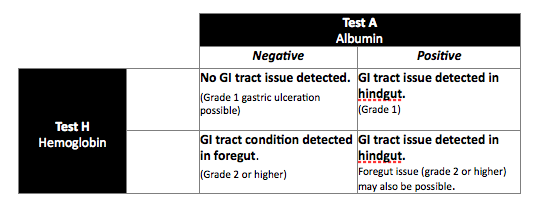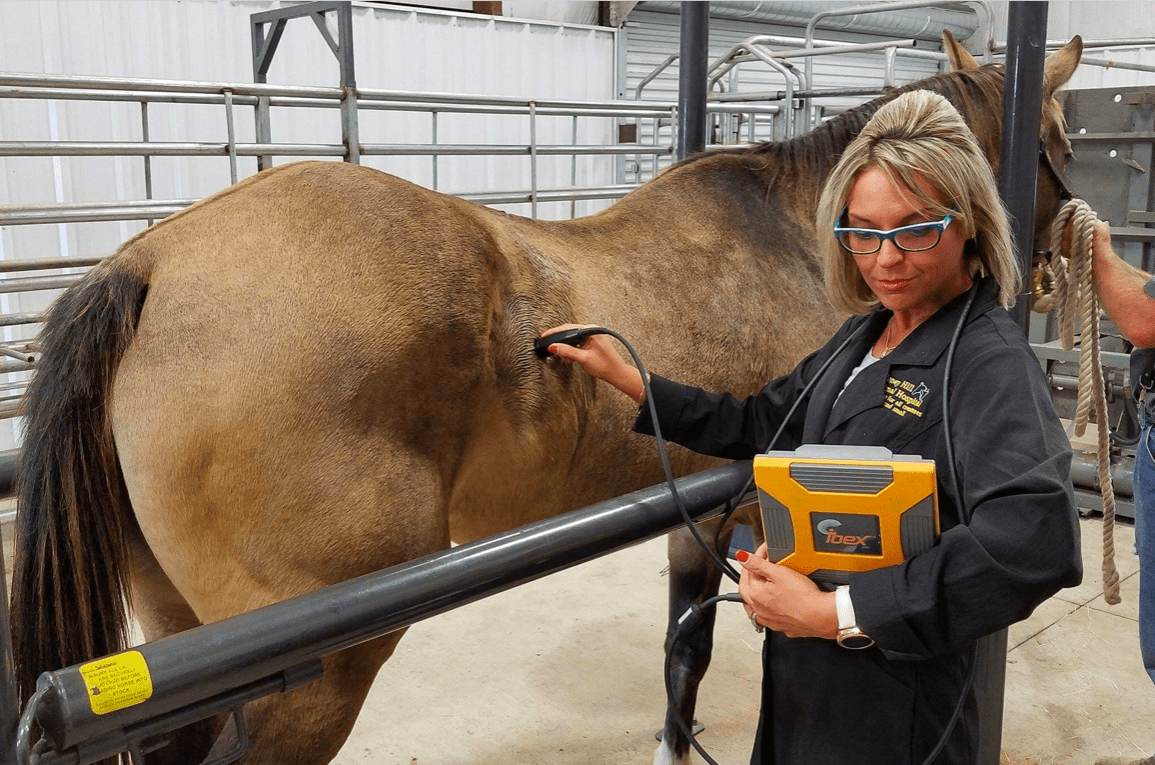Although the FBT is very simple to administer, the interpretation of results is complicated by the fact that it is a two-part test. Test A and Test H results must be read together to provide a complete set of data. (Watch our step-by-step instructional video.)
In this article we will explain what different combinations of Test A and Test H results may mean. With this information, the FBT can best aid the practitioner’s differential diagnosis of GI tract conditions in their equine patients.
Understanding Equine Fecal Blood Test Results
Any compromise to the integrity of the GI tract lining may result in the loss of blood proteins into the tract which may be detected by the SUCCEED FBT. By detecting two separate proteins – Test A detects Albumin (Ab) and Test H detects Hemoglobin (Hg) – the FBT can further determine whether the source of this loss is in the hindgut, the foregut or both.
Our research demonstrated the meaning of the protein markers relative to GI tract injury location:
- Albumin in the feces (positive Test A) is indicative of injury at locations caudal to the common bile duct in the proximal portion of the small intestine (or, generally, in the hind gut).
- Hemoglobin (positive Test H) can result from injury anywhere along the GI tract.
(Read more about how the blood protein markers indicate foregut vs. hindgut injury.)
At the same time, the presence of Hg in a fecal sample (positive Test H) resulting from GI tract ulceration can occur if the ulceration is grade 2 or higher (where the presence of whole blood is likely). Albumin, by contrast, may be present at the site of low-grade injury absent whole blood. Thus a positive Test A result may indicate ulceration of grade 1 or higher in the hindgut. (Conversely, a negative Test H may occur with ulceration of grade 1 as this reflects a low-level injury that does not produce hemoglobin.)
As a result of these factors, the following chart illustrates the potential interpretation of the various combinations of positive and negative FBT results:
Using FBT Results to Guide Diagnosis
The detection of fecal occult hemoglobin and/or albumin with the SUCCEED FBT provides the practitioner with additional objective information to consider in conjunction with a horse’s history, a physical examination and blood work.
While there are several conditions which may lead to the presence of these blood proteins in manure, the research supporting the FBT reflects a PPV upwards of 96% for the detection of ulceration. Therefore ulceration, whether gastric or colonic, would appear to be the most common diagnosis following a positive FBT result.
In cases where other diagnostic indicators likely rule out ulceration as the underlying condition, the following may be considered:
- Iatrogenic factors such as NSAID or antibiotic administration can put the GI tract at risk from colitis or enteritis, with the right dorsal colon most commonly affected. Bacterial colitis caused by clostridium bacteria can also result in blood and protein loss from the GI tract.
- Starch-induced laminitis, high grain/low fiber diets, sudden dietary changes, stress and any imbalance in the hindgut microflora can result in hindgut acidosis. Often this condition is a precursor to subsequent colitis, endotoxemia or ulceration.
- The causes of inflammatory bowel disease are multi-factorial; however, loss of protein from the gut is commonly presented.
- The FBT can detect any blood or protein loss as a result of a colic episode, and can also be used post colic surgery to monitor blood loss.
- Extreme parasitism
- An albumin positive result may indicate a protein losing enteropathy.
If a negative result for albumin is recorded for a fecal sample, but blood work indicates hypoalbuminea or hypoproteinemia, then urine can also be tested using the FBT to help diagnose a protein losing nephropathy.
Since the FBT is completely non-invasive it can also be used in foals to help diagnose bacterial conditions such as lawsonia intracellularis or salmonellosis.
It is important when using the FBT to eliminate any external factors which may produce a positive result in the absence of a GI tract condition. A false positive relative to GI tract conditions may be caused by anything which introduces blood to the digestive tract from sources external to the GI tract, including recent dentistry, exercise induced pulmonary hemorrhage (EIPH) or ovulation. For more information on this, read our recent article, “When NOT to Use the Fecal Blood Test.”
For more information about possible test results and what they mean, contact Freedom Health.



